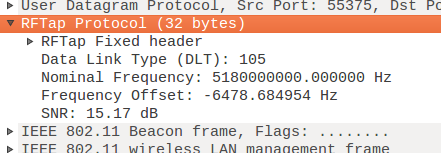IEEE Wireless Communications Letters added an early access paper that demonstrates ZigBee/WiFi Co-Transmission using both our WiFi and ZigBee transceiver.
Bastian Bloessl defended his PhD thesis, titled A Physical Layer Experimentation Framework for Automotive WLAN, and graduated summa cum laude from Paderborn University.
The thesis contains a comprehensive overview of our WLAN transceiver and research projects that were facilitated by our WLAN transceiver.
Our paper *mSync: Physical Layer Frame Synchronization Without Preamble Symbols* was just accepted for publication in the IEEE Transactions on Mobile Computing.
In the paper, we propose a frame format and a corresponding decoding strategy that does not rely on dedicated preamble symbols. To evaluate our approach, we implement the algorithm for a custom low-power PHY, but also for the IEEE 802.15.4 O-QPSK PHY.
The *Futebol* Project is a collaboration between [Brasil](http://www.ict-futebol.org.br/) and the [Europe](https://cordis.europa.eu/project/rcn/199149_en.html) that facilitates testbed-based wireless research.
The recent [project report](https://repository.uantwerpen.be/docman/irua/80a8be/148666.pdf) describes how our IEEE 802.15.4 transceiver can be used for *Experimental Wireless Networking Research using Software-Defined Radios*.
One core assumption of many network simulators is that interference and noise have a similar impact on the performance of the physical layer. We were curious if this is actually the case and conducted simulations as well as experiments in an SDR-based testbed. The results will be published at IEEE VNC 2017 in Torino, Italy.
Researchers from the University of Minnesota used our WiFi and ZigBee transceiver to prototype their novel approach for physical-layer cross-technology communication. Their paper won the best paper award at ACM MobiCom 2017. Congratulations!
We used our WiFi transceiver implementation to study the impact of noise and interference on IEEE 802.11p. Whether there is a significant difference between noise and interference is very relevant for networks simulations, which often use very simplistic simulation models for the physical layer.
We are very happy that our paper summarizing the implementation and validation of our WiFi transceiver was accepted for publication in IEEE Transactions on Mobile Computing.
On 29 September 2017, Bastian Bloessl will participate in [Probe: Research uncovered](https://www.tcd.ie/research/probe/programme/) at Trinity College Dublin. He will be around at Café Curie where Marie Curie Fellows have the chance to chat about their work and give short talks.
Researchers from Spain used our WiFi transceiver for Chaos-Based Coded Modulations. Hopefully, the transceiver did not contribute to the chaos :-)
Researchers from Erlangen-Nürnberg and Mannheim use our IEEE 802.15.4 (ZigBee) transceiver in their paper on the (in)security of ZigBee 3.0 touchlink commissioning. The paper is [available online](https://www1.cs.fau.de/filepool/publications/wisec2017_touchlink.pdf).
Bastian Bloessl received a Marie Skłodowska-Curie Fellowship, allowing him to spent two more years continuing the works in the context of the Wime project. During his fellowship, he will stay at the CONNECT Centre, Trinity College Dublin -- Ireland's Research Centre for Future Networks and Communications.
Researchers from Uruguay did some really nice work on our WiFi transceiver. In their paper, published at the 9th Latin America Networking Conference (LANC'16), they present performance optimizations through more efficient demapping of constellation points and an alternate implementation of the viterbi decoder.
We are grateful that the authors contributed their modifications. They are already part of the current version.
Researchers from Technische Universität Berlin just released a [paper](http://www.tkn.tu-berlin.de/fileadmin/fg112/Papers/2016/gawlowicz16uniflex_TR.pdf), in which they use our WiFi transceiver to prototype their vision of a software-defined wireless network.
Jonathan Bucker shows in his [blog post](https://rftap.github.io/blog/2016/09/01/rftap-wifi.html) how to detect MAC address spoofing by associating a device with a characteristic carrier frequency offset. He uses our WiFi transceiver together with [RFtap](https://rftap.github.io/) to make the frequency offset estimate available in Wireshark.

A group from Ohio State University used our IEEE 802.11a/g/p transceiver in their recent paper, to be presented at ACM MobiCom 2016.
We're very happy to launch our new website, which will serve as the main source of information for everything related to the Wime project. We will use it as an outlet for theses, projects, and papers that use our tools.
If you have anything that should be added, please drop us an email. We will be happy to update the website.
A group from University of Washington used our IEEE 802.11a/g/ transceiver and our findings regarding the scrambler seeds of WiFi cards to show the feasibility of inter-technology backscatter communication. The paper will be presented at ACM SIGCOMM 2016.
The first paper that uses the new channel estimation algorithms of our IEEE 802.11a/g/p transceiver was just accepted for presentation at ACM CarSyS 2016, which will be held in conjunction with ACM MobiCom.
The paper compares the performance of channel estimation algorithms in various environments using recorded traces from field tests. The data mentioned in the paper is already available on our website.
A group from University of Bremen presented a paper on prototyping channel estimation algorithms with our IEEE 802.11a/g/p transceiver. The authors are already working on getting their algorithm upstream. Great!
Graduate students at Ohio State University use our WiFi transceiver in their project on autonomous driving.
Bastian Bloessl just won the DAAD FitWeltweit scholarship, allowing him to spent six months at the UCLA NRL Lab to work on the Wime Project.
Bastian Bloessl just demonstrated Automatic Gain Control for our IEEE 802.11a/g/p transceiver at Infocom 2015.
David Eckhoff just presented a paper introducing the Scrambler Attack, a novel finger printing technique that relies on data extracted with our IEEE 802.11a/g/p transceiver.
Bastian Bloessl presented our GNU Radio WiFi transceiver at FOSDEM 2014 in Belgium.
We just received the Best Demo Paper at Vehicular Networking Conference (VNC) 2013 for our paper about the GNU Radio IEEE 802.11a/g/p implementation.
We just received the Best Demo Award at ACM MobiCom 2013 for demonstrating our GNU Radio IEEE 802.11a/g/p implementation.